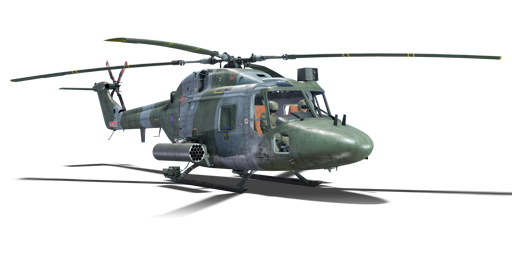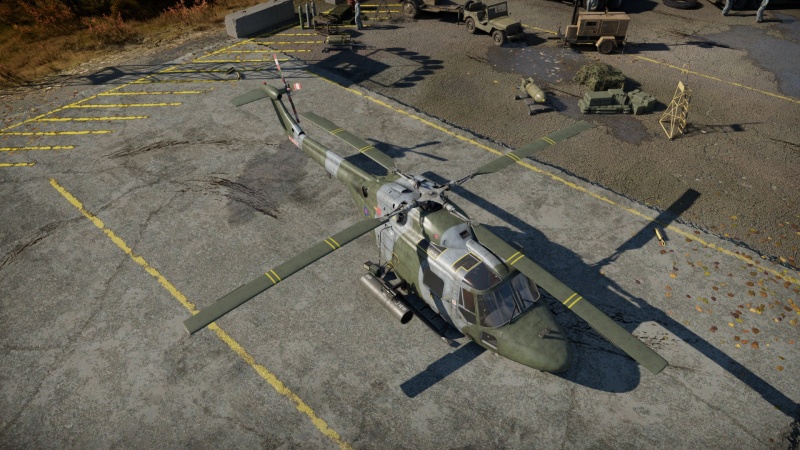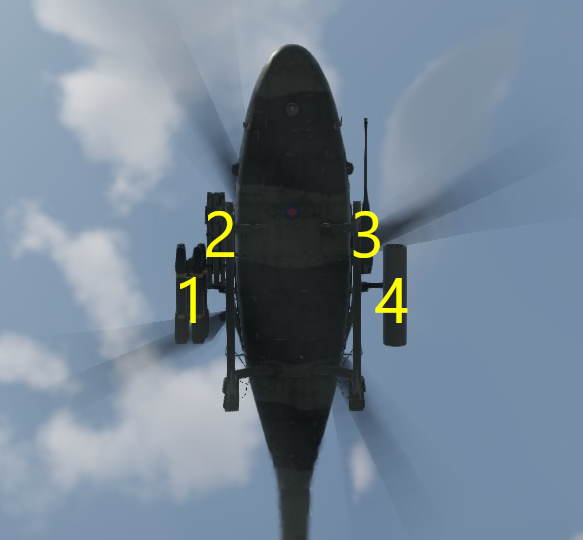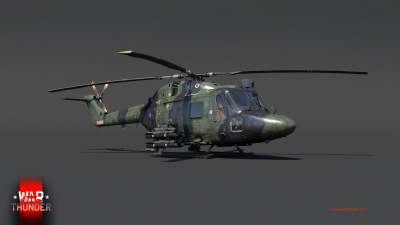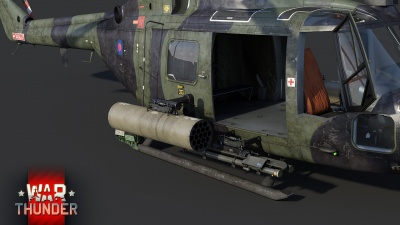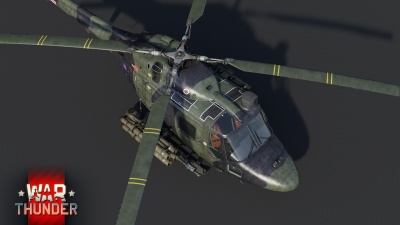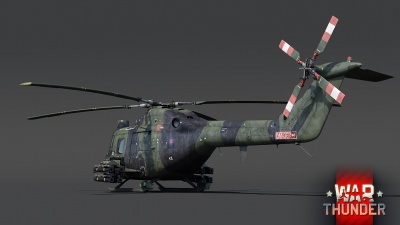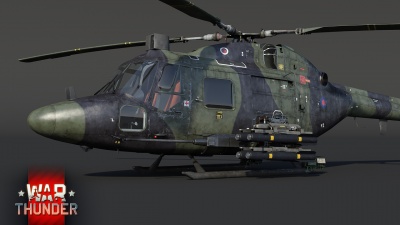Lynx AH.Mk.1
| This page is about the British helicopter Lynx AH.Mk.1. For the premium version, see G-LYNX. |
Contents
Description
Development on the Lynx began in the mid 1960s, when Westland sought a replacement for its existing Scout and Wasp helicopters, while also wanting to provide a more advanced alternative to the UH-1 Iroquois. After some delays, the first prototype was ready for testing by the early '70s. In March 1971, the prototype conducted its maiden flight. In further sorties, the Lynx managed to break a number of world speed records for helicopters. the British Army placed an order for 100 units of the type to be produced in the mid '70s. Subsequently, the Lynx received its official army designation. Lynx helicopters found themselves taking part in numerous conflicts, including the Falklands and Gulf wars, military interventions on the Balkans during the 1990s, anti-piracy efforts in Somalia and many more thanks to their ongoing service today. In total, around 450 Lynx helicopters of various modifications have been produced by 2009, with production still ongoing today.
It was introduced in Update 1.91 "Night Vision". The Lynx represents a complete game change for British helicopter pilots when compared to the Wasp. It's faster, more agile, and sports a wide array of combat payloads from Hydra-70 rocket pods up to the fearsome AGM-114B Hellfire guided missiles. The guns return with the option to take a 20 mm Oerlikon cannon and regardless of your loadout there is always an option for a pair of AIM-92 Stinger missiles to round out the complement and help fend off enemy aircraft. All this weaponry can be guided and supported by a suite of equipment such as thermal imaging gunner sights and plentiful flare/chaff pods. However the survivability is poor since it lacks armour, and the zoom for the gunner optics is extremely poor, so target acquisition at long ranges may prove challenging.
General info
Flight performance
The Lynx boasts one of the best flight profiles for helicopters in the game. When stock the helicopter can be stiff upon take off, and slow to get up to speed and altitude, but once flight is achieved and the Lynx has gotten going, it handles superbly. Able to perform tight acrobatics like rolls and very hard turns, this performance only increases as the aircraft is upgraded. The handling of the helicopter can greatly reward its early grind as it allows effective deployment of its fixed cannon and rocket pods.
The helicopter will be a lot different in feel to its predecessors within the British tech tree, able to be thrown about with almost wild abandon. Do make sure to practise the usual rules of collective management during turns, and note that you will not dump as much altitude as other helicopters when performing acrobatic rolls due to the agility, which sounds good in theory and can allow the helicopter to fight right next to the tanks in confined spaces, but in everyday reality can cause you to not move enough to evade incoming missiles as often the manoeuvre is relied upon to do.
| Characteristics | Max Speed (km/h at 1,000 m) |
Max altitude (metres) | |
|---|---|---|---|
| AB | RB | ||
| Stock | 249 | 233 | 3500 |
| Upgraded | 297 | 273 | |
Survivability and armour
The Lynx boasts no armour protection of any sort on or within the aircraft. However, as with most British helicopters, the vital components are well-spaced apart meaning a significant portion of the aircraft is empty space. All of the fuel tanks present within the main body of the Lynx are self-sealing in the event of leaks. An engine fire system is available when the aircraft is upgraded to extinguish engine fires and keep the Lynx airborne when receiving critical amounts of damage.
The helicopter is small for its role, meaning that it overall presents a smaller profile to hit, however it is not on the tiny scale of its predecessors within the tech tree and British pilots should account for this increased size when piloting this aircraft.
Modifications and economy
It is advisable to prioritise unlocking the Chaff/flare modification for the Lynx as this will allow the helicopter to have a fighting chance at shaking off IR AAMs: while pilot skill is always an option, flares allow much more breathing room and will throw off certain AAMs that can pull more than 12 G. A mobile aircraft even stock, the TOW weapons tree should be focused next, unlocking the first of the Lynx's devastating selection of guided anti-tank ordnance. The tree can be followed down neatly to the AGM-114B Hellfires which will present the strongest weaponry the Lynx can employ. However, due to needing tier unlocks, it is highly recommended to unlock the AIM-92 Stingers and the NVD upgrades as the player goes, allowing the aircraft to defend itself better from enemy aircraft while also unlocking thermal imaging for the gunner which makes the unlocked ATGMs even more potent with faster target acquisition.
Armaments
Offensive armament
The Lynx AH.Mk.1 is armed with:
- A choice between two presets:
- Without offensive armament
- 192 x countermeasures
Suspended armament
The Lynx AH.Mk.1 can be outfitted with the following ordnance presets:
- 1 x 20 mm Oerlikon KAD-B cannon (570 rpg) + 38 x Hydra-70 M247 rockets
- 4 x ATAS (AIM-92) missiles
- 38 x Hydra-70 M247 rockets
- 2 x BGM-71C Improved TOW missiles
- 4 x BGM-71C Improved TOW missiles
- 8 x BGM-71C Improved TOW missiles
- 4 x BGM-71D TOW-2 missiles
- 8 x BGM-71D TOW-2 missiles
- 4 x AGM-114B Hellfire missiles
- 8 x AGM-114B Hellfire missiles
- 1 x 20 mm Oerlikon KAD-B cannon
- 1 x 20 mm Oerlikon KAD-B cannon + 8 x BGM-71D TOW-2 missiles
Custom loadout options
| 1 | 2 | 3 | 4 | ||
|---|---|---|---|---|---|
| 20 mm Oerlikon KAD-B cannons (570 rpg) | 1 | ||||
| Hydra-70 M247 rockets | 19 | 19 | |||
| AGM-114B Hellfire missiles | 2, 4 | 2, 4 | |||
| ATAS (AIM-92) missiles | 2 | 2 | |||
| BGM-71C Improved TOW missiles | 2, 4 | 2, 4 | |||
| BGM-71D TOW-2 missiles | 2, 4 | 2, 4 | |||
| Maximum permissible weight imbalance: 200 kg | |||||
20 mm Oerlikon KAD-B cannon:
The 20 mm cannon on the Lynx is adequate for its uses, it can take an air target or armoured target belt as the player wishes. The belt's armour piercing option is an HVAP-T (High Velocity Armour Piercing-Tracer) round, which can allow penetration of up to 57 mm of armour at very close range. At the BR, this is mostly insufficient against any ground target unless firing directly down into the tops of turrets or engine blocks, with little-to-no post penetration effect due to the inert nature of the round. The air belts will prioritise the HEFI-T (High Explosive Fragmentation Incendiary-Tracer) which with its fast fire rate can shred other helicopters, harrying jets, or open-topped vehicles.
ATAS (AIM-92) missile:
The Lynx can carry 2-4 Stingers depending on the pilot's preference (the second pair replaces the autocannon). The AIM-92 is similar to the FIM-92 found on the LAV-AD in the american tech tree but as an air-to-air variant. The missile is all-aspect and has some ECCM capabilities, however in most weather conditions it only boasts a maximum range of 5 km or even 3.5 km at worst, which may be too close for comfort for some pilots when it concerns jets.
The missile only possesses up to 10G of overload which can be insufficient against aircraft who are actively paying attention to the actions of the Lynx. To minimize the amount of fuel the missile wastes during launch and increase hit chance tenfold it is necessary to perform a short 90 degree roll into enemy movement direction to change inertia vector of the helicopter to that of the enemy, but in doing so pilot wastes precious time which could be spent avoiding attacks.
Hydra-70 M247 rocket:
The common Hydra-70 rocket, found on such other aircraft as the AH-1F and others in the USA tech tree, is a dumb-fired rocket with up to 290 mm of armour penetration, 1.19 kg TNT equivalent explosive per missile, and a HEAT warhead. This can be defeated by ERA which will begin to occur at this BR and earlier. However it is sufficient and able to reliably kill tanks with direct hits. The Lynx can carry a maximum of 38 Hydra rockets.
It is extremely important to know, that the third person view aiming application is inaccurate without ballistic computer and is nearly useless to aim short rocket salvos. Hydras should be aimed using holographic scope in cockpit (pilot) view instead. This scope accurately portrays the real spread of rockets and will almost without a failure point out the effect of inertia and overload on the result (unless the overload is so heavy that the scope leaves the screen). The pilot still has to account for the lesser inertia effects himself, as rockets will deviate from the middle dot in the direction the helicopter is drifting, but this is still magnitudes better than simply guessing.
BGM-71C Improved TOW missile:
The 71C is the first-unlocked guided munition of the Lynx. It boasts a maximum of 630 mm of armour penetration with an effective guidance range of 3.75 km which it travels at 296 m/s. The missile is SACLOS (Semi-Automatic Command to Line of Sight) meaning that it must be guided for the entire duration of the flight, breaking the designation will cause the missile to simply fly forward and occasionally self-destruct. This type of missile guidance can be defeated by soft-kill APS systems like those found on the PUMA which will be a commonly encountered opponent. Each missile contains the equivalent of 2.88 kg of TNT. The warhead is HEAT and can be defeated by ERA armour. This missile will still destroy any tank without composite armour encountered at the battle rating on direct hit.
| The little square on ATGM control area UI represents the TOW ATGM launch area and general width of the ATGM control area. It is extremely small, compared even to some other helicopters, which would normally imply that the helicopter would have to face the target or pilot would have to sit in the gunner seat and carefully aim for the entirety of the ATGM flight time. However, the Lynx ATGM camera actually turns by itself with the lock-on and therefore can circumvent normal SACLOS limitations. If pilot turns on the lock (done automatically with "lock onto target" button when pointing near the eligible target; indicated with a square around the target), the sight will follow the target, therefore properly launched TOW will naturally stay within control area of the sniper sight, as it will follow the target as well. The implication is, even if the pilot does evasive manoeuvres after aquiring the lock, it will be difficult to break the ATGM controls as long as they are fired in the middle of the "launch zone". This allows the Lynx to almost automatically destroy nearly anything (including other helicopters) even with SACLOS ATGM while firing AAM at unwanted visitors or dodging in the middle of attacking just like the Scout or the Wasp. |
If the lock-on of the sight became glitchy due to a sheer number of targets (including dead tank hulls) being close to each other, or the missile is following an aircraft in a sub-optimal way, consider pressing the lock button again to offset the aim (the circle will appear next to the lock-on square indicating where the missile is currently aimed relatively to the locked target)
BGM-71D TOW-2 missile:
The 71D is an upgrade to the above 71C. It does not offer any improvement on range, maintaining the 3.75 km maximum with a slightly increased travel speed of 329 m/s. The missile is still SACLOS. However, each missile contains 4.41 kg of TNT equivalent. The warhead is HEAT and can be defeated by ERA armour, but otherwise the missile will reliably destroy almost anything encountered at the battle rating and has enough explosive filler to overpressure some lighter vehicles even if critical hit is not achieved.
AGM-114B Hellfire missile.
The Hellfire missile is arguably the ultimate upgrade for the Lynx, the missile more than doubles the attack range of the older TOW missiles with a maximum range of 8 km which it can travel at 475 m/s. The missile is Laser guided meaning that it relies on laser designation unlike the older missiles and cannot be defeated by soft-kill APS systems like the TOW. The laser also can guide multiple missiles at once, if necessary.
However, the laser will trigger Laser Warning Systems (LWS) alerting some targets and prompting them to use ESS or smoke grenades, which will break the lock. To circumvent that, missiles have IOG (Inertial On-board Guidance), meaning that they can direct themselves semi-accurately even without laser pointer. This feature can be used to leave after launching the missiles or to launch missiles without laser designation at all while still being locked onto target (The user should first disable the "enable laser designator before launch" in "air battle settings" to avoid triggering LWS), the missiles will then fly into general direction of the target. This allows the helicopter to turn the laser on at the last 1/3 or even 1/4 of the remaining missile flight path, leaving even paranoid opponents with no time to react. This attack type is further supported by a special timer next to the hellfire ammunition counter, which specifically tells how long it will take for the last fired missile to arrive at the target.
Be aware that the missiles are not smart enough to actually guide themselves into targets without laser and will occasionally crash themselves early when launched from too far away, unless launched from the similar height with the intended target to reduce a chance of a misfire. Should the pilot forget about it, the sniper scope will show "ENABLE LASER NOW" message when the missiles get into guaranteed kill range (not necessarily when the missiles are about to crash due to a poor launch).
Missile also can run afoul of some stronger ERA or NERA armours, but with an incredible 1,100 mm of armour penetration this is very unlikely. This excellent penetration also comes with explosives equivalent to 9.02 kg of TNT which again is double that of its preceding TOW, allowing to overpressurize even many medium tanks. Anything at the receiving end of a Hellfire rain will certainly feel it, ending up crippled even if not outright destroyed.
Usage in battles
The Lynx can perform very admirably when sporting rocket pods and providing very close-in CAS. With excellent agility and a mostly empty airframe it can pull tight turns around tank coaxial and commander machine guns and deliver its payload up close, however this is a very meagre payload of 38 rockets. While the Hydra-70s will surely bring down most targets they will demand much more skill as careful aiming and ammunition conservation under fire can be a daunting prospect for helicopters that find themselves as one of the most vulnerable battlefield vehicles next to SPAA. This will need to be employed early when grinding the initial unlocks for TOW missiles and serve as an excellent training basis for learning how to handle the Lynx.
Once TOWs have been unlocked, the Lynx will gain the option to revert back to the playstyle seen in the aircraft that came before it in the British tech tree, albeit eventually with far more powerful and further reaching weaponry. The TOW missiles do not sport much more range than the AS.11s used on the Wasp, but fly much faster and hit far harder. Furthermore, 8 may be carried as opposed to the previous payload of only 4 ATGMs on older helicopters. However the stakes are higher at the battle rating and the array of enemy SPAA and even the advent of light tanks and IFVs like the Bradley or the BMP will make getting up close incredibly perilous.
Care should be taken to assess the battlefield and, if choosing to deploy the Lynx, make sure it has adequate cover when utilising the TOWs due to their shorter range. Somewhere to perform 'masking' manoeuvres (hovering behind hills/buildings or other defilades to protect the helicopter from retaliating fire between attacks) can be critical to the player's success in this aircraft. Bear in mind also that the TOW munitions are SACLOS which means they must be guided for the entire duration of flight. While less risky than the rocket pods, the TOW missiles still run great risk but will punch harder and can reward the pilot with devastating firepower that can cripple entire flanks of an enemy team.
A further and final upgrade comes in the form of the AGM-114B Hellfire missiles. These missiles double the range of the TOW missiles and can introduce the player to their first example of Laser + IOG (In-Ordnance Guidance) weapon systems. The tactics employed are much the same as detailed before concerning the TOW missiles, however they also afford the player to make such decisions and plays as out-ranging enemy SPAA systems, especially ones based on cannons over guided munitions. However, care should be taken to avoid becoming overconfident, this is the age of the laser rangefinder and hovering perfectly stock still can serve the pilot up on a platter to an enterprising MBT with an APFSDS or HE-VT shell to send into the cabin of the aircraft. It is advisable to alter your course gently and randomly with regularity, 'drifting' softly to make acquiring you a harder target to most. At 8 km of range the Hellfires will keep you safe from most if not all cannon SPAA such as the Gepard or M163.
Hellfires can be left to their own devices through the use of their Laser + IOG nature. If evasive manoeuvres are required, the Lynx can duck away and deal with the missile and if time allows re-acquire laser designation on the target. While the laser is broken the missile will fly towards the last lasered location unlike SACLOS munitions. However if the target moves the missile will not track this and keep going to the last fixed point, a warning will show on the HUD saying 'Engage laser now' to advise the missile is nearing the terminus of its flight and requires the laser to adjust if the target has moved. Creativity can be advised in using the missiles in a rudimentary fire and forget fashion if the player is confident their target will not move, firing the missile and ducking away into safety without guiding it. With a continuous laser lock, the Hellfire will guide itself like a SACLOS weapon onto its target with devastating effect.
In conclusion, the Lynx can be employed very flexibly in a large number of ways. The player can choose to use it as a long-range Hellfire sniper, or an agile and slippery rocket-pod sporting hunter, menacing SPAA and light vehicles by getting within their comfort zones.
Pros and cons
Pros:
- Able to carry 8 powerful AGM-114B Hellfires, which can scrap any tank, although carrying this many will significantly impact helicopter's agility
- Incredibly agile airframe when not overburdened by heavy missiles
- Able to supplement anti-tank loadouts with anti-air missiles and/or 20 mm autocannon
- Turret can track locked target without further pilot input, can use ATGM like AAM if required as a side effect
- Has functional holographic scope for rockets in cockpit view (but not in 3rd person view), allowing for aiming consistency at a certain price
Cons:
- Will encounter some powerful aircraft at its tier that its defensive armaments will do little to protect it from
- AAMs are unreliable and cannot pull many Gs, mostly used as a scare rather than a real weapon
- The 20 mm cannon is fixed on the left side of the helicopter and not able to be aimed independently of the aircraft's nose, has little to no effect on tanks
- Although this helicopter is super agile and can do extreme aerobatics, it will do little to protect the helicopter from HE-VT fired by some light tanks and overzealous SPAA
History
Development on the Lynx began in the mid 1960s, when Westland sought a replacement for its existing Scout and Wasp helicopters, while also wanting to provide a more advanced alternative to the UH-1 Iroquois.
After some delays, the first prototype was ready for testing by the early '70s. In March 1971, the prototype conducted its maiden flight. In further sorties, the Lynx managed to break a number of world speed records for helicopters. Quite content with the Lynx's performance, the British Army placed an order for 100 units of the type to be produced in the mid '70s. Subsequently, the Lynx received its official army designation 'Lynx AH Mk.1'.
Since its introduction to service, the Lynx saw service primarily with the British Army and the Royal Navy in various different roles, including among others transport, armed escort and anti-tank warfare. Furthermore, the Lynx also saw service with countries such as the Netherlands, Norway and Argentina, while other countries like Germany, France, Denmark, South Korea, Brazil and Portugal, to name a few, still use variants of the Lynx today.
During their service, Lynx helicopters found themselves taking part in numerous conflicts, including the Falklands and Gulf wars, military interventions on the Balkans during the 1990s, anti-piracy efforts in Somalia and many more thanks to their ongoing service today. In total, around 450 Lynx helicopters of various modifications have been produced by 2009, with production still ongoing today.
- From Devblog
Media
- Skins
- Images
See also
External links
| Westland Aircraft Limited | |
|---|---|
| Aircraft | |
| Fighters | Whirlwind Mk I · Whirlwind P.9 |
| Turboprop | Wyvern S4 |
| Helicopters* | |
| Attack | AH Mk.1 Apache** |
| Utility | Wessex HU Mk.5 · Scout AH.Mk.1 · Wasp HAS.Mk.1 · Lynx AH.Mk.1 · G-LYNX |
| *After World War II, Westland Aircraft focused on building helicopters and changed its name to Westland Helicopters. | |
| **Licensed AH-64D | |
| See Also | Boeing Aircraft |
| Britain helicopters | |
|---|---|
| Attack | AH Mk.1 Apache · Rooivalk Mk1F CSH · Superhind |
| Utility | Wessex HU Mk.5 · Scout AH.Mk.1 · Wasp HAS.Mk.1 · Lynx AH.Mk.1 · G-LYNX |


